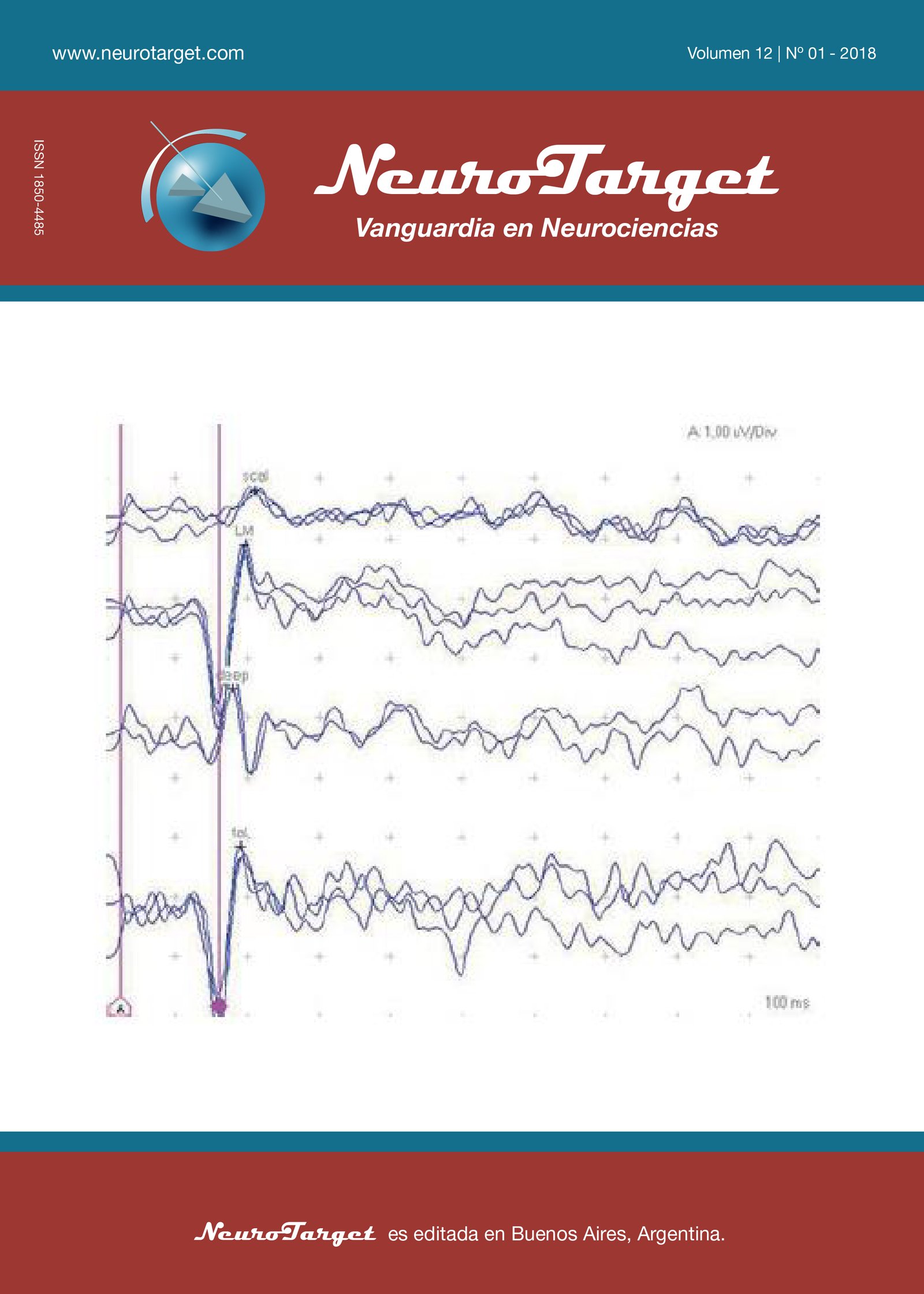Fractura de extensión de electrodos en estimulación cerebral profunda para distonía cervical: reporte de caso y revisión de la literatura.
DOI:
https://doi.org/10.47924/neurotarget2023115Palabras clave:
Estimulación cerebral profunda, Distonía, Cables extensores, InterescapularResumen
La estimulación cerebral profunda (ECP) es utilizada como un método eficaz, adaptable y reversible para el tratamiento de diversas condiciones neurológicas. A pesar de su concepto mínimamente invasivo, estos procedimientos no se encuentran exentos de complicaciones. En este trabajo presentamos el caso de un paciente portador distonía cervical secundaria al uso de neurolépticos asociada a trastorno obsesivo compulsivo, quien recibió implante de electrodos cerebrales profundos en ambos globos pálidos internos. Evolucionó con brusca reaparición de los síntomas por la rotura de los cables extensores en dos oportunidades. Describimos la resolución del caso mediante la colocación de extensores expandibles y la reubicación del generador en el espacio interescapular, así como una revisión actualizada de la literatura.
Métricas
Citas
Krack P, Batir A, Van Blercom N, Chabardes S, Fraix V, Ar- douin C, et al. Five-year follow-up of bilateral stimulation of the subthalamic nucleus in advanced Parkinson’s disease. N Engl J Med 2003;349:1925-34.
Cif L, El Fertit H, Vayssiere N, Hemm S, Hardouin E, Gannau A, et al. Treatment of dystonic syndromes by chronic electrical stimulation of the internal globus pallidus. J Neurosurg Sci 2003;47:52-5.
Benabid AL, Pollak P, Gervason C, Hoffmann D, Gao DM, Hommel M, et al. Long-term suppression of tremor by chronic stimulation of the ventral intermediate thalamic nucleus. Lancet 1991;337:403-6.
Benabid AL, Pollak P, Louveau A, Henry S, de Rougemont J. Combined (thalamotomy and stimulation) stereotactic surgery of the VIM thalamic nucleus for bilateral Parkinson disease. Appl Neurophysiol 1987;50:344-6.
Berk C, Carr J, Sinden M, Martzke J, Honey CR. Thalamic deep brain stimulation for the treatment of tremor due to multiple sclerosis: a prospective study of tremor and quality of life. J Neurosurg 2002;97:815-20.
Denys D, Mantione M, Figee M, van den Munckhof P, Koerselman F, Westenberg H, et al. Deep brain stimulation of the nucleus accumbens for treatment-refractory obsessivecompulsive disorder. Arch Gen Psychiatry 2010;67:1061-8.
Houeto JL, Karachi C, Mallet L, Pillon B, Yelnik J, Mesnage V, et al. Tourette’s syndrome and deep brain stimulation. J Neurol Neurosurg Psychiatry 2005;76:992-5.
Kondziolka D, Whiting D, Germanwala A, Oh M. Hardware- related complications after placement of thalamic deep brain stimulator systems. Stereotact Funct Neurosurg 2002;79:228-33.
Lyons KE, Wilkinson SB, Overman J, Pahwa R. Surgical and hardware complications of subthalamic stimulation: a series of 160 procedures. Neurology 2004;63(4):612-6.
Alesch F. Sudden failure of dual channel pulse generators. Mov Disord 2005;20(1):64-6.
Chou KL, Siderowf AD, Jaggi JL, Liang GS, Baltuch GH. Unilateral battery depletion in Parkinson’s disease patients treated with bilateral subthalamic nucleus deep brain stimulation may require urgent surgical replacement. Stereotact Funct Neurosurg 2004;82(4):153-5.
Machado AG, Hiremath GK, Salazar F, Rezai AR. Fracture of subthalamic nucleus deep brain stimulation hardware as a result of compulsive manipulation: case report. Neurosurgery 2005;57(6):13-8.
Okun MS, Tagliati M, Pourfar M, et al. Management of referred deep brain stimulation failures: a retrospective analysis from 2 movement disorders centers. Arch Neurol 2005;62(8):1250-5.
Beric A, Kelly PJ, Rezai A, Sterio D, Mogilner A, Zonenshayn M, Kopell B. Complications of deep brain stimulation surgery. Stereotact Funct Neurosurg 2001;77:73-8.
Binder DK, Rau GM, Starr PA. Risk factors for hemorrhage during microelectrode-guided deep brain stimulator implantation for movement disorders. Neurosurgery 2005;56:722-32.
Umemura A, Jaggi JL, Hurtig HI, Siderowf AD, Colcher A, Stern MB, Baltuch GH. Deep brain stimulation for movement disorders: morbidity and mortality in 109 patients. J Neurosurg 2003;98:779-84.
Fenoy AJ, Simpson Jr RK. Risks of common complications in deep brain stimulation surgery: management and avoidance. J Neurosurg 2014;120(1):132-9.
Vidailhet M, Vercueil L, Houeto JL, Krystkowiak P, Benabid AL, Cornu P, et al. Bilateral deep-brain stimulation of the globus pallidus in primary generalized dystonia. N Engl J Med 2005;352:459-67.
Boviatsis EJ, Stavrinou LC, Themistocleous M, Kouyialis AT, Sakas DE. Surgical and hardware complications of deep brain stimulation. A seven-year experience and review of the literature. Acta neurochirurgica 2010;152(12):2053-62.
Kondziolka D, Whiting D, Germanwala A, Oh M. Hardware-related complications after placement of thalamic deep brain stimulator systems. Stereotact Funct Neurosurg 2002;79:228-33.
Senatus PB, McClelland III S, Ferris AD, Ford B, Winfield LM, Pullman SL, Goodman RR. Implantation of bilateral deep brain stimulators in patients with Parkinson disease and preexisting cardiac pacemakers: report of two cases.J Neurosurg2004;101(6):1073-7.
Descargas
Publicado
Cómo citar
Número
Sección
Licencia
Derechos de autor 2018 Fabián Cremaschi, Alejandro Vázquez, Fabián C. Piedimonte

Esta obra está bajo una licencia internacional Creative Commons Atribución 4.0.
Este artículo se distribuye bajo la licencia Creative Commons Attribution 4.0 License. A menos que se indique lo contrario, el material publicado asociado se distribuye bajo la misma licencia.







